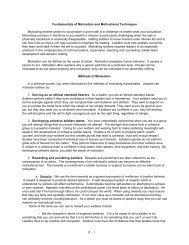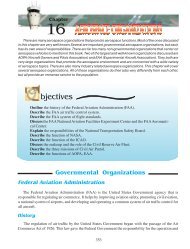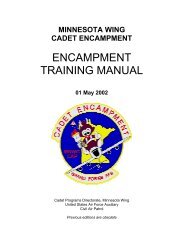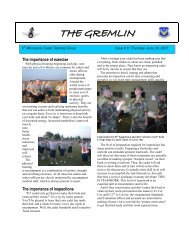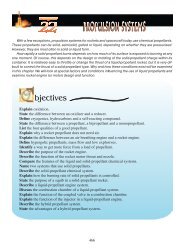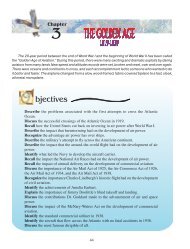specific interests of the donors, volunteers, and staff associatedwith them, thereby employing a supplyside rationale.Supply-side functions also include socialentrepreneurship, whereby commercial venues are usedto foster charitable goals (Frumkin 2002; Young and Salamon2002). Nonprofits achieve reciprocity when theyrecognize and celebrate the match between donor interestsand their own.Level 4: Instilling the Value of RespectThe ability to attain status and respect is important to anonprofit organization’s credibility and is equivalent toMaslow’s concept of individual esteem needs. At thislevel of organizational culture development, the nonprofitis respected by others and, as well, has respect foritself and others. Employees feel worthwhile and appreciated.Donors, volunteers, and clients are treated as integralmembers of the team.What Grace (2006) terms the donor-investor relationshipembodies how nonprofits garner respect. Grace imploresnonprofits to take a development rather than fundraisingapproach to resource recruitment. Development involvescultivating relationships with donors that induce them toview their contributions as an investment in the workbeing done by the nonprofit organization.Developing relationships with donor-investors goes beyondsimply asking for money. Donors are viewed as integralteam members, with a specific interest in the workbeing done and a desire to invest in the organization as awhole, not simply to write a check. Because philanthropyis defined as “all voluntary action for the public good”(Grace 2006, 1), volunteers are celebrated as donor-investors.Level 5: Integrity and the Self-Actualized Nonprofit OrganizationThe highest value in an ethical organizational culture isintegrity, equivalent to Maslow’s concept of individualself-actualization. Integrity is defined not only as incorruptibility,but as completeness of commitment to ethicalbehavior. With integrity, an organization has an internalizedmoral code, is able to engage in creative problemsolving,and pursues its mission to the fullest extentpossible. Nonprofits that have achieved integrity assumea stewardship role in serving the public.Aspiring to integrity and fulfilling the ethical hierarchy ofneeds is important if nonprofit organizations are to enjoythe full confidence of the public. Ethical governance ofnonprofits is necessary to maintain their integrity. Attainingintegrity relies on achieving financial competence, accountability,reciprocity, and respect. Building and maintainingsocial capital is essential to the ability of nonprofitorganizations to mobilize support and engage in collectiveaction (Jeavons 2005, 223).Scaling the HierarchyCan ethics be regulated? This framework identifies thelevels of ethical development whereby nonprofit organizationsreach and attain integrity. While nonprofits canbe taught ethical practices, they cannot be forced to actethically. External controls can be imposed on nonprofitsto move them through financial competence and accountability,as well as to contribute to achieving reciprocity.However, only by internalizing ethical behaviors and patternscan a nonprofit attain integrity.Internal and External ControlsLegislation, Internal Revenue Service (IRS) rules and regulations,and contract stipulations for the receipt of grantfunds are all external controls on the operations of a nonprofitorganization. Often these requirements are precipitatedby scandals that raise awareness of a particularvulnerability. External controls may be sufficient to imposefinancial competence and accountability on a nonprofit,but without an internalized commitment to ethics, theorganization will not move beyond Level 3—Reciprocity.The following sections present examples of scandals thathave affected nonprofit organizations. The examplesshould not be interpreted as empirical evidence butrather as descriptors of the model’s concepts to facilitateempirical tests. They illustrate the obstacles to movingthrough the hierarchy of ethical values and prescriptionsfor overcoming them. Although the focus here is on externalcontrols as both necessary and sufficient to achieveLevels 1 and 2, attention is also paid to the internal controlmechanism that is crucial for organizations to reachthe upper levels.Financial Mismanagement (Level 1)Like all organizations, nonprofits are not immune to scandal.Allegations of financial misconduct are the most prevalent,and ultimately the most damaging to the nonprofitorganization and the voluntary sector as a whole. Chargedand subsequently convicted of fraud and misuse of donorfunds, Jim Bakker caused a scandal that not only broughtabout the demise of PTL Ministries in 1987 but contaminatedother evangelical ministries by harming their reputationsand their fundraising efforts (Jeavons 2005, 214).The Ohio division of the American Cancer Society suf-58
fered stinging repercussions from the loss of $7 millionthrough embezzlement. Proper safeguards were not inplace to prevent this—the same employee kept records,reconciled bank accounts, and had direct access to organizationfunds. The questions raised concerned not onlywhy this individual had such easy access, but also whythe organization had $7 million cash on hand (“Theftfrom Cancer Society” 2000).A Chronicle of Philanthropy review of 10,770 nonprofit organizationaltax records from 1998 to 2001 revealed thatmore than 1,002 charities made $142 million in loans totheir directors, officers, or key employees (Davis 2004, 1).In 2004, People United for a Better Oakland (PUEBLO)came under fire for routinely making personal loans toboard members and the executive director. The boardchair claimed that organizations that work with povertyoften have to take such “emergency measures” (Jacksonand Fogarty 2005, 125). However, the loans were notmade to the poor, unemployed, or disenfranchised; rather,they were made to (and sometimes not repaid by) boardmembers, employees, and organization supporters. In addition,about $500,000 was unaccounted for betweenMarch 2002 and March 2004 (Johnson 2004).While staff members of nonprofits are typically underpaidrelative to the market, some large nonprofit organizationsoften argue that it takes high salaries to attractcapable executives to assist in fundraising and attractmajor gifts. On June 14, 2004, Carl Yeckel, former presidentof the Dallas-based Carl B. and Florence E. KingFoundation, and Thomas Vett, the foundation’s formersecretary, were ordered by a jury to pay $14 million incompensatory and punitive damages to the King Foundation.Yeckel and Vett were censured for excessive executivesalaries and amassing personal charges on thefoundation’s credit cards (Osborn 2004).In 2001, Hale House (a nonprofit dedicated to servingdrug-addicted and abandoned babies in Harlem) facedscandal when shelter director Lorraine Hale was accusedof stealing money from the organization. Hale and herhusband were later sentenced to five years of probationand ordered to pay restitution for the $766,000 they hadembezzled (Saltonstall and Evans 2004, 32; “Shelter’s Ex-Director” 2002). After the scandal broke, the number ofdonors dropped dramatically from 200,000 to 12,000; twoyears later, the donor base had increased to only 50,000,one-fourth the pre-scandal size (Souccar 2004, 14).Each of the scandals mentioned above involved issues offinancial competency. Early in their development, nonprofitorganizations may have more lax fiscal systems inplace, due either to the administrative inexperience of theleadership or to a high degree of assumed trustworthinesswithin the group. Financial mismanagement is less likelyto occur in organizations that internalize ethics early; forthose without a strong internal orientation toward ethics,disasters like the ones described above may ensue.Accountability (Level 2)The prohibition against distributing profits means, in theory,that members of a board of directors have no otherincentive than to act according to the best interests of theorganization and its clients. Trust as a substitute for monitoring,however, is problematic when it leads to a disengagedboard that is more susceptible to scandal. Transparencyfacilitates engagement and is an antidote to scandal.Two members of the board of directors of the United Wayof the National Capital Area (UWNCA) were removedwhen they pressed for open financial records; they pressedfor access after being told they were not entitled to seefinancial statements (Strom 2003, 1). Subsequently, a topexecutive stole $500,000 from the charity and its pensionfund (Hananel 2004). Later, the entire board of directorswas replaced after allegedly inflating the organization’sfundraising figures, understating overhead costs, andovercharging for administrative fees (Owen 2003).The Nature Conservancy came under heavy scrutiny afterthe Washington Post reported that it had purchased landfrom Georgia-Pacific during the time that Georgia- Pacific’schairman sat on the Nature Conservancy board(Bobelian 2004, 4). Conservancy board members soldland to the Conservancy and then bought property fromit. The leadership of the Nature Conservancy was alsoroundly criticized for not more carefully scrutinizing taxdeductions taken by donors and for failure to make its financesmore public (Stephens 2004, A01).In 2004, a local California chapter of the American RedCross released detailed reports on how it had spent fundsafter the wildfires in October 2003. The reports revealedthat the nonprofit had spent 67 percent (or $3.9 million)of its funds directly on fire victims. This stands in starkcontrast to revelations from the Alpine fire in 2001, whenan audit showed that only 10 percent of funds raised wentto the fire victims (Vigil 2004). A scandal ensued inwhich fire victims and the public wanted to know howdonations were spent and how funds were managed.Achieving Levels 1 and 2Although organizations cannot be forced to act ethically,legal requirements can encourage achievement of Levels1 and 2 of the hierarchy. Organizations receive (and main-59
- Page 1 and 2:
VOLUME FOUR STRATEGIC PERSPECTIVESL
- Page 3 and 4:
VOLUME FOUR STRATEGIC PERSPECTIVESL
- Page 5 and 6:
VOLUME FOUR STRATEGIC PERSPECTIVESL
- Page 7:
VOLUME FOUR STRATEGIC PERSPECTIVESL
- Page 10 and 11: 12CHAPTER 12INTRODUCTION TO STRATEG
- Page 12 and 13: 12.1 Strategic Leadership: Defining
- Page 14 and 15: mandates or resolutions that would
- Page 16 and 17: and ambiguity, aspiring strategic l
- Page 18 and 19: 12.2 National Security StrategyThe
- Page 20 and 21: within our borders has always been
- Page 22 and 23: front common challenges like violen
- Page 24 and 25: and our strategy, not sector earmar
- Page 26 and 27: thinking about organizations. She m
- Page 28 and 29: A systemic approach to failure is m
- Page 30 and 31: The late W. T. Grant Company is a r
- Page 32 and 33: the resources - setting the directi
- Page 34 and 35: focal point for describing and inte
- Page 36 and 37: Consequently, we do not restrict th
- Page 38 and 39: paragraphs, Web pages, then edit an
- Page 40 and 41: Web, can be viewed as a CS attempt
- Page 42 and 43: How to evaluate users and contribut
- Page 44 and 45: 13CHAPTER 13LEADING PUBLIC &VOLUNTE
- Page 46 and 47: 13.1 Leadership for Volunteers:The
- Page 48 and 49: 13.2 Take Root: Volunteer Managemen
- Page 50 and 51: QualificationsClearly list educatio
- Page 52 and 53: and effectively track their volunte
- Page 54 and 55: • Understand rules for recognitio
- Page 56 and 57: • Send a birthday card.• Submit
- Page 58 and 59: and tested more than six decades af
- Page 62 and 63: tain) tax-exempt status from the In
- Page 64 and 65: Smucker, 1999).The Internal Revenue
- Page 66 and 67: culture is necessary to ensure the
- Page 68 and 69: 13.4 The New Look of TransparencyBy
- Page 70 and 71: ees for a couple of reasons: One, i
- Page 72 and 73: 13.5 Public and Private Management:
- Page 74 and 75: TABLE 1:FUNCTIONS OF GENERAL MANAGE
- Page 76 and 77: 3. Career System. The model corpora
- Page 78 and 79: islative charter - the Clean Air Ac
- Page 80 and 81: In controlling performance, Chapin
- Page 82 and 83: 14CHAPTER 14AIRPOWER ASSTRATEGIC LA
- Page 84 and 85: 14.1 Strategic Air Power: Fulfillme
- Page 86 and 87: carry it out. Their daylight raids
- Page 88 and 89: you did not rely on strategic bombi
- Page 90 and 91: 14.2 Warden and the Air Corps Tacti
- Page 92 and 93: ecomes one of applying sufficient i
- Page 94 and 95: tification, and a Jominian claim to
- Page 96 and 97: courage the rapid and widespread ex
- Page 98 and 99: it to influence physical players in
- Page 100 and 101: 14.4 Basic Air Force DoctrineAF Doc
- Page 102 and 103: earthquake-stricken Haiti. The worl
- Page 104 and 105: perspective. Airmen do not divide u
- Page 106 and 107: Command and ControlCommand and cont
- Page 108 and 109: 14.5 Should the US Maintain the Nuc
- Page 110 and 111:
form of human government.” 20 Dem
- Page 112 and 113:
obtainable goal. See the Global Zer
- Page 114 and 115:
15CHAPTER 15ORGANIZATIONAL CULTURE
- Page 116 and 117:
15.1 Organizational CultureBy Doria
- Page 118 and 119:
Review. This action strives to unco
- Page 120 and 121:
gram will serve and then having the
- Page 122 and 123:
ticipating the changes being made b
- Page 124 and 125:
Many years of working with change p
- Page 126 and 127:
At the least, the areas of concern
- Page 128 and 129:
15.4 Developing an Innovative Cultu
- Page 130 and 131:
CONCLUDING THOUGHTSIn an ever-chang
- Page 132 and 133:
global issues. Businesses that poss
- Page 134 and 135:
— Sees the big picture—the shif
- Page 136 and 137:
16CHAPTER 16STRATEGIC COMMUNICATION
- Page 138 and 139:
16.1 Principles of Strategic Commun
- Page 140 and 141:
16.2 The Art of NegotiationBy Brend
- Page 142 and 143:
16.3 Negotiating Effectively Across
- Page 144 and 145:
hidden areas can act as cultural ho
- Page 146 and 147:
and four conflict styles. Hammer be
- Page 148 and 149:
maintaining the relationship. As th
- Page 150 and 151:
25 Mitchell R. Hammer, “Chapter 1
- Page 152 and 153:
tural, socioeconomic, and psycholog
- Page 154 and 155:
for the win-win," during which time
- Page 156 and 157:
interests and, at worst, as a gun s
- Page 158 and 159:
Public diplomacy is surely about mu
- Page 160 and 161:
But public diplomats do not have th
- Page 162 and 163:
Photo courtesy of the familyThe LEA
- Page 164:
THE CADET OATHI pledge that I will



